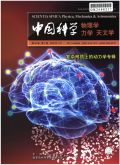- 钛学术文献服务平台 \
- 学术期刊 \
- 基础科学期刊 \
- 自然科学总论期刊 \
- 中国科学(物理学 力学 天文学)期刊 \
null
Terahertz-dependent PM2.5 monitoring and grading in the atmosphere
基本信息来源于合作网站,原文需代理用户跳转至来源网站获取
摘要:
Rapid industrialization and economic development have led to serious pollution in the form of fine particulate matter (PM2.5,particulate matter with a diameter of less than 2.5 μtm).In China,PM2.5 has been one of the most debated topics in councils of government and issues of public concern.Terahertz (THz) radiation was employed to measure the PM2.5 in the atmosphere from September 2014 to April 2015 in Beijing.Comparison of the PM2.5 level from the website with THz absorbance revealed a significant phenomenon:THz radiation can be used to monitor PM2.5 in the atmosphere.During Asia-Pacific Economic Cooperation (APEC) 2014,"APEC Blue" was also recorded in a THz system.The relationship between absorbance and PM2.5 demonstrates that THz radiation is an effective selection for air pollution grading.Based on the absorbance spectra,the elemental compositions were studied by two-dimensional correlation spectroscopy (2DCOS) in conjunction with X-ray fluorescence.Several single absorption peaks were revealed and caused by sulphate from coal combustion,vehicle exhaust emissions and secondary reactions.Furthermore,mathematical algorithms,such as the BPANN and SVM,can process the THz absorbance data and greatly improve the precision of the estimation of PM2.5 mass.Our results suggest that THz spectroscopy can not only reveal the component information for pollution source determination,but quantitatively monitor the PM2.5 content for pollution level evaluation.Therefore,the use of THz radiation is a new method for future air pollution monitoring and grading systems.

推荐文章
期刊_丙丁烷TDLAS测量系统的吸收峰自动检测
带间级联激光器
调谐半导体激光吸收光谱
雾剂检漏 中红外吸收峰 洛伦兹光谱线型
不同盐度、温度及光照对漂浮浒苔生理生态的影响
浒苔
盐度
温度
光照
生理生态
期刊_联合空间信息的改进低秩稀疏矩阵分解的高光谱异常目标检测
高光谱图像
异常目标检测 低秩稀疏矩阵分解 稀疏矩阵 残差矩阵
内容分析
关键词云
关键词热度
相关文献总数
(/次)
(/年)
文献信息
| 篇名 | Terahertz-dependent PM2.5 monitoring and grading in the atmosphere | ||
| 来源期刊 | 中国科学(物理学 力学 天文学) | 学科 | |
| 关键词 | |||
| 年,卷(期) | 2018,(10) | 所属期刊栏目 | |
| 研究方向 | 页码范围 | 60-69 | |
| 页数 | 10页 | 分类号 | |
| 字数 | 语种 | 中文 | |
| DOI | |||
五维指标
引文网络
引文网络
二级参考文献 (0)
共引文献 (0)
参考文献 (1)
节点文献
引证文献 (0)
同被引文献 (0)
二级引证文献 (0)
2010(1)
- 参考文献(1)
- 二级参考文献(0)
2018(0)
- 参考文献(0)
- 二级参考文献(0)
- 引证文献(0)
- 二级引证文献(0)
引文网络交叉学科
相关学者/机构
期刊影响力
中国科学(物理学 力学 天文学)
主办单位:
中国科学院
出版周期:
月刊
ISSN:
1674-7275
CN:
11-5848/N
开本:
出版地:
北京东黄城根北街16号
邮发代号:
创刊时间:
语种:
chi
出版文献量(篇)
2745
总下载数(次)
4
总被引数(次)
14752
期刊文献
相关文献
推荐文献
- 期刊分类
- 期刊(年)
- 期刊(期)
- 期刊推荐
力学
化学
地球物理学
地质学
基础科学综合
大学学报
天文学
天文学、地球科学
数学
气象学
海洋学
物理学
生物学
生物科学
自然地理学和测绘学
自然科学总论
自然科学理论与方法
资源科学
非线性科学与系统科学
中国科学(物理学 力学 天文学)2022
中国科学(物理学 力学 天文学)2021
中国科学(物理学 力学 天文学)2020
中国科学(物理学 力学 天文学)2019
中国科学(物理学 力学 天文学)2018
中国科学(物理学 力学 天文学)2017
中国科学(物理学 力学 天文学)2016
中国科学(物理学 力学 天文学)2015
中国科学(物理学 力学 天文学)2014
中国科学(物理学 力学 天文学)2013
中国科学(物理学 力学 天文学)2012
中国科学(物理学 力学 天文学)2011
中国科学(物理学 力学 天文学)2010
中国科学(物理学 力学 天文学)2009
中国科学(物理学 力学 天文学)2008
中国科学(物理学 力学 天文学)2007
中国科学(物理学 力学 天文学)2006
中国科学(物理学 力学 天文学)2005
中国科学(物理学 力学 天文学)2004
中国科学(物理学 力学 天文学)2003
中国科学(物理学 力学 天文学)2018年第9期
中国科学(物理学 力学 天文学)2018年第8期
中国科学(物理学 力学 天文学)2018年第7期
中国科学(物理学 力学 天文学)2018年第6期
中国科学(物理学 力学 天文学)2018年第5期
中国科学(物理学 力学 天文学)2018年第4期
中国科学(物理学 力学 天文学)2018年第3期
中国科学(物理学 力学 天文学)2018年第2期
中国科学(物理学 力学 天文学)2018年第12期
中国科学(物理学 力学 天文学)2018年第11期
中国科学(物理学 力学 天文学)2018年第10期

 免费查重
免费查重










